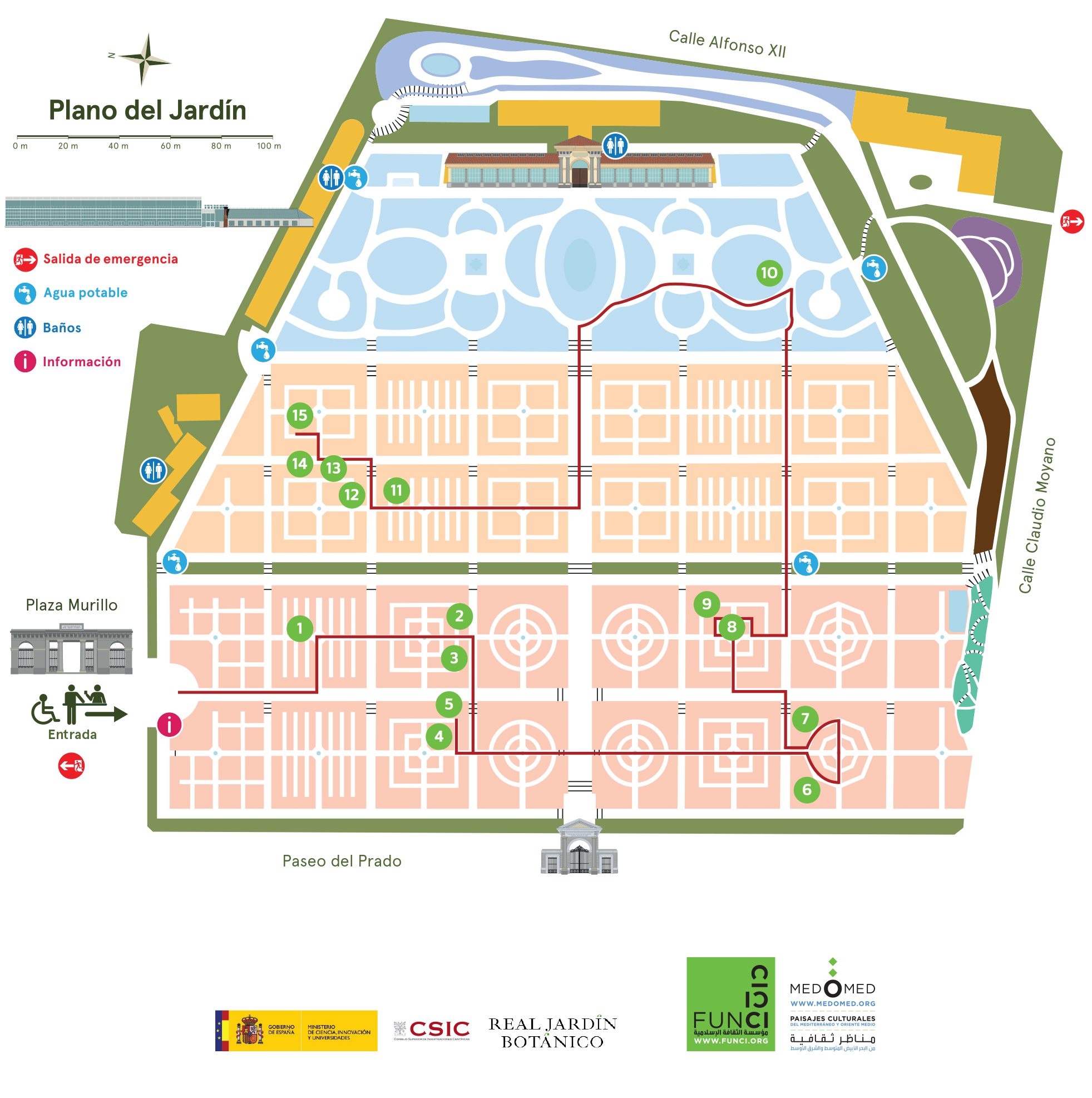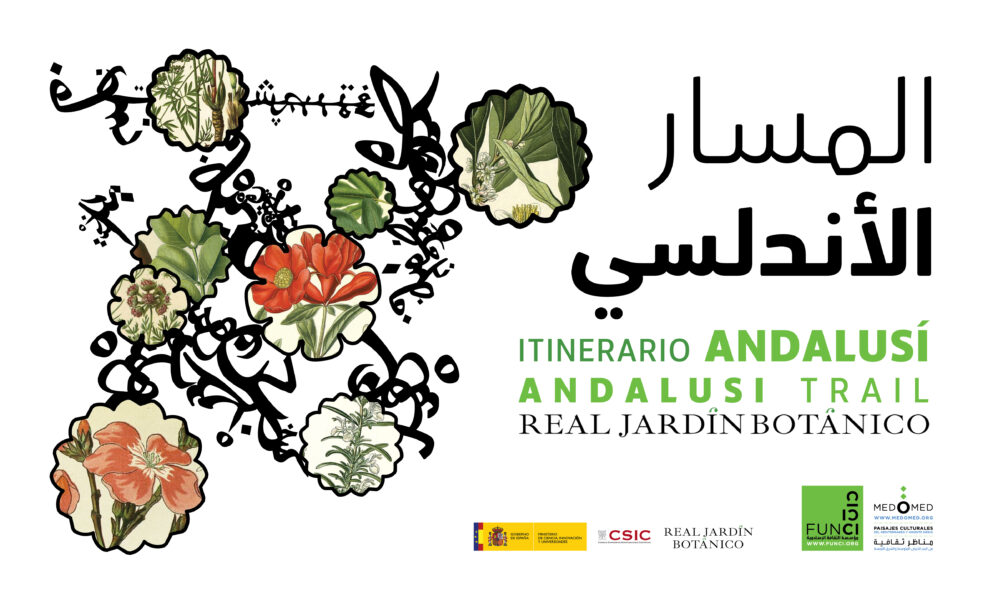“Andalusi Trail”, Madrid, Spain
The Royal Botanical Garden-CSIC and the Islamic Culture Foundation are delighted to offer the public a selection of plants commonly used in al-Andalus, as a visual and olfactory journey through time and space spanning eight centuries of history and intercultural coexistence.
When the Imazighen and Arab troops crossed the Strait of Gibraltar in 711, they not only initiated a new historical period in the Iberian Peninsula, known as al-Andalus, they also kickstarted a period of great cultural and scientific splendour. Agriculture and botany were greatly enriched with new species of ornamental, aromatic, medicinal, and edible plants, among many others. Following their introduction and acclimatization in the peninsula, many of these species are now naturalized.

1. Cupressus sempervirens L. • CIPRÉS COMÚN • السَّرو • CYPRESS
2. Foeniculum vulgare L. • HINOJO • الشمرة • FENNEL
3. Olea europaea L. subsp. europaea. • OLIVO • الزيتون • OLIVE
4. Laurus nobilis L. • LAUREL • الرَّنـد/الغار • BAY TREE
5. Myrtus communis L. subsp. baetica (L.) Casares & Tito • MIRTO, ARRAY.N MORISCO • الآس/الريحان • MIRTLE
6. Ceratonia siliqua L. • ALGARROBO • الخرُّوب/الخرنوب • CAROB TREE
7. Ficus carica L. • HIGUERA • شجرة التين • COMMON FIG
8. Lavandula spp. • LAVANDA, ESPLIEGO, ALHUCEMA • الخزامى/اللاوندة • LAVENDER
9. Melissa officinalis L. • TORONJIL, MELISA • الترنجان/المليسة • LEMON BALM
10. Cedrus spp. • CEDRO • الأرز • CEDAR
11. Salvia rosmarinus (L.) Schleid. = Rosmarinus officinalis L. • ROMERO • إكليل الجبل • ROSEMARY
12. Jasminum grandiflorum L. • JAZM.N • الياسميـن • JASMINE
13. Nerium oleander L. • ADELFA, BALADRE • الدفلى • OLEANDER
14. Melia azedarach L. • CINAMOMO, MELIA, AGRIAZ • أزدرخت • CHINABERRY TREE
15. Punica granatum L. • GRANADO • الرُّمـّان • POMEGRANATE
The Royal Botanical Garden (RJB), a member of the Botanical Gardens Network of the Mediterranean and the Middle East (Med-O-Med) since 2009, is a privileged historical institution located in the heart of Madrid. It was inaugurated in 1774 at its current location on the Paseo del Prado during the reign of Carlos III. It is currently managed by the Spanish National Research Council (CSIC) under the auspices of the Ministry of Science and Innovation and has been declared an Artistic Garden and National Monument.
The Andalusi Trail is the fruit of this collaboration. It originated out of a desire to educate the wider public as to the natural legacy of al-Andalus, which remains largely unknown, in spite of its significant presence in our everyday landscape. The itineray is an opportunity to travel back in time and experience Islamic Spain of the 8th to the 15th centuries through the colours and aromas of a selection of 15 plants which are cultivated in the Royal Botanical Garden.
Participants on the itineray will have the opportunity to learn about the customs and habits of the inhabitants of the Iberian Peninsula during the al-Andalus period. They will learn about the contributions their illustrious ancestors made to science, botany, and popular culture. We would like to invite you to enjoy this sensory, historical experience as a means of discovering the past in order to better understand the present.
Please follow this link for details of the al-Andalus guided tour.
THE ANDALUSI TRAIL
The Royal Botanical Garden-CSIC and the Islamic Culture Foundation are delighted to offer the public a selection of plants commonly used in al-Andalus, as a visual and olfactory journey through time and space spanning eight centuries of history and intercultural coexistence. When the Imazighen and Arab troops crossed the Strait of Gibraltar in 711, they not only initiated a new historical period in the Iberian Peninsula, known as al-Andalus, they also kickstarted a period of great cultural and scientific splendour. Agriculture and botany were greatly enriched with new species of ornamental, aromatic, medicinal, and edible plants, among many others. Following their introduction and acclimatization in the peninsula, many of these species are now naturalized.
THE BOTANICAL LEGACY OF AL-ANDALUS
The era of al-Andalus (711 to 1492) left its mark on the daily life of the Iberian Peninsula, its architecture, its way of life, its traditions, its language, and its agricultural landscape. During the al-Andalus period, gardens played a pivotal role. Some have survived to this day, such as those of the Alhambra in Granada; the Nazari Botanical Garden in Vélez de Benaudalla; and the Patio del Yeso in the Alcázar, and the Patio de la Contratación, both in Seville. The gardens of al-Andalus were not limited to the classic ‘de crucero’ layout with a central path which sought to reflect a representation of the spiritual orchard. Instead they displayed great morphological and conceptual diversity.
The great appreciation for nature felt by the inhabitants of al-Andalus, whether Muslim or of other faiths, led to a poetic movement, known as rawdiyat (from Ryad, ‘garden’, in Arabic), the result of the well-being produced by the proximity of these orchards and gardens. Nevertheless, these meeting spaces were not only aesthetically appealing and pleasing to the senses, they were also highly utilitarian and productive.
At the time of al-Andalus, water management was conducted wisely, and a scientific approach was taken to acclimatizing new botanical species, leading to significant scientific developments. Some of the agronomists who were responsible for the acclimatization and care of species which were introduced to the Iberian Peninsula went on to become highly valued royal gardeners. Many of them wrote treatises on agriculture and botany which have survived to the present day. Some of the most celebrated were Abulcasis (10th-11th centuries), Ibn Bassal and Ibn Wafid (11th century), both from Toledo, al-Tignari (11th-12th centuries), and Ibn Al-Awwam (12th-13th centuries) from Seville, among many others.
A REFLECTION OF CULTURAL SYMBIOSIS
The botanical species closely linked to the culture of al-Andalus occupy an important place in the Royal Botanical Garden’s vast wide-ranging collection. The itineray is just a small sample of this legacy, which dates back to the Early Middle Ages and whose origin ranges from the Far East to the Maghreb. The Andalusi Trail is a means to discover the agricultural culture and landscape of the time, which has largely survived to the present day.
The species which best capture the essence of the al-Andalus culture can still be found in our daily surroundings. They include plants with culinary uses such as fruit, vegetables and forage trees (pomegranate, carob, olive, fig, lemon, apple, garlic, onion, melon, watermelon, eggplant and artichoke, for example), in addition to others which are used as spices or those from which seasonings are extracted (such as rosemary, lavender, lemon balm, mint, basil, oregano, laurel, fennel, cinnamon, cloves, parsley and pepper). In addition to being excellent for cooking, many species were also valued for their medicinal properties or used as ornamental plants. To this end, species such as oleander, cypress, cedar, myrtle, cinnamon, jasmine, bitter orange, water lily, rose, white lily and narcissus were acclimatized in gardens and private properties in order for people to observe them and derive pleasure from them.
The itineray is a small sample of a legacy which has largely survived to the present day. We invite visitors to discover some of these plants which are featured on the itineray or hidden in a corner of this fascinating historic garden.
Our current knowledge has been obtained from a compilation of multiple sources which vary in terms of their origin, chronology and authorship. As mentioned previously, poetry and scientific treatises serve as key primary sources. However, we can also find texts of a historical, religious nature (both Islamic and Christian), in addition to other genres, which shed light on the matter. The following are a selection of quotes from witnesses to history, for the reader’s pleasure and enjoyment:
“It would seem as if al-Andalus and all of Spain have been nothing but a vast garden in which flowers and trees flaunted their most seductive colours.”
H. Péres (1990).
“Oh, inhabitants of al-Andalus, what happiness
Is yours to have waters, shadows, rivers, and
Trees!
The Garden of Eternal Happiness is not outside
Of you, but in your land; if I had a choice, this is the place I would choose.
Do not believe that tomorrow you will enter into
Hell. One does not enter Hell after
Having been in Paradise!”
Ibn Khafaja (10th – 11th century).
“Whoever obeys
Allah and His Messenger
will be admitted by Him to Gardens
beneath which rivers flow,
abiding eternally therein.”
Quran (Surah 4, verse 13).
“They will not hear any frivolous talk there
or any sinful speech,
but only the saying of ‘Peace! Peace!’
And the blessed ones will
reside there among sidra trees,
laden with fruit and acacias in
bloom, and an extensive shade,
and flowing waters, and abundant fruit that will not be exhausted,
nor will it be out of reach.”
Quran (Surah 56, verses 25-33).
“God planted a garden in Eden, in the East, and there He placed the man whom He had formed. He caused every kind of beautiful and delicious tree to grow out of the ground, and in the middle of the garden were the Tree of Life and the Tree of Knowledge of Good and Evil. A river flowed out of Eden to water the garden, and from there it divided and became four rivers. The first was named Pishon… the second was named Gihon… the third was named Tigris… and the fourth was named Euphrates.”
Genesis 2:8-14.
“Often the garden is adorned with gentle rain
like a striped [Yemeni] fabric,
which inspires souls to pause and sit.
When the breeze brushes it with its hand, we imagine
its branches as graceful dancers swaying
in their green dresses of striped cloth.”
Abu Marwan Ibn Razin (11th century).
“The daffodils are silver ingots,
with cups of pure gold placed upon them.”
Ibn Darrach al-Qastalli (10th – 11th century).
“The jasmine on its branches are like emeralds,
sprinkled with precious pearls.”
Ibn al-Jatib (14th century).
“The lotus petals form a Kaaba of silver,
within which the Black Stone is found.”
al-Mu‘tádid (11th century).
“Behold, to delight your eyes, a lush garden,
where the breeze never ceases to blow and the rain to fall.
It will show you the art of San’a in the patterns
that adorn its garments,
which appear to be crafted in Tustar.”
Abu-l Qasim al Balnu (11th century).
Please follow this link for details of the al-Andalus guided tour.
VISITOR INFORMATION SERVICE
91 420 04 38
Mon to Fri, from 9.00 to 14.00
Organized by the Royal Botanical Garden (RJB-CSIC) and the Islamic Culture Foundation (FUNCI)

